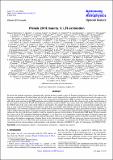Por favor, use este identificador para citar o enlazar a este item:
http://hdl.handle.net/10261/110569COMPARTIR / EXPORTAR:
 SHARE SHARE
 CORE
BASE CORE
BASE
|
|
| Visualizar otros formatos: MARC | Dublin Core | RDF | ORE | MODS | METS | DIDL | DATACITE | |

| Título: | Planck 2013 results. V. LFI calibration |
Autor: | Tomasi, M.; Barreiro, R. Belén CSIC ORCID ; Bonavera, Laura CSIC ORCID; Curto, Andrés CSIC; Diego, José María CSIC ORCID ; González-Nuevo, J. CSIC ORCID; Herranz, D. CSIC ORCID ; López-Caniego, M. CSIC ORCID; Martínez-González, Enrique CSIC ORCID ; Rebolo López, Rafael CSIC ORCID; Toffolatti, L. CSIC ORCID; Vielva, Patricio CSIC ORCID ; Planck Collaboration | Palabras clave: | Methods: data analysis Cosmic background radiation Instrumentation: polarimeters |
Fecha de publicación: | 2014 | Editor: | EDP Sciences | Citación: | Astronomy and Astrophysics 571: A5 (2014) | Resumen: | We discuss the methods employed to photometrically calibrate the data acquired by the Low Frequency Instrument on Planck. Our calibration is based on a combination of the orbital dipole plus the solar dipole, caused respectively by the motion of the Planck spacecraft with respect to the Sun and by motion of the solar system with respect to the cosmic microwave background (CMB) rest frame. The latter provides a signal of a few mK with the same spectrum as the CMB anisotropies and is visible throughout the mission. In this data releasewe rely on the characterization of the solar dipole as measured by WMAP. We also present preliminary results (at 44 GHz only) on the study of the Orbital Dipole, which agree with the WMAP value of the solar system speed within our uncertainties. We compute the calibration constant for each radiometer roughly once per hour, in order to keep track of changes in the detectors' gain. Since non-idealities in the optical response of the beams proved to be important, we implemented a fast convolution algorithm which considers the full beam response in estimating the signal generated by the dipole. Moreover, in order to further reduce the impact of residual systematics due to sidelobes, we estimated time variations in the calibration constant of the 30 GHz radiometers (the ones with the largest sidelobes) using the signal of an internal reference load at 4 K instead of the CMB dipole. We have estimated the accuracy of the LFI calibration following two strategies: (1) we have run a set of simulations to assess the impact of statistical errors and systematic effects in the instrument and in the calibration procedure; and (2) we have performed a number of internal consistency checks on the data and on the brightness temperature of Jupiter. Errors in the calibration of this Planck/LFI data release are expected to be about 0.6% at 44 and 70 GHz, and 0.8% at 30 GHz. Both these preliminary results at low and high â.,> are consistent with WMAP results within uncertainties and comparison of power spectra indicates good consistency in the absolute calibration with HFI (0.3%) and a 1.4σ discrepancy with WMAP (0.9%). | Versión del editor: | http://dx.doi.org/10.1051/0004-6361/201321527 | URI: | http://hdl.handle.net/10261/110569 | DOI: | 10.1051/0004-6361/201321527 | Identificadores: | doi: 10.1051/0004-6361/201321527 issn: 1432-0746 e-issn: 0004-6361 |
| Aparece en las colecciones: | (IFCA) Artículos |
Ficheros en este ítem:
| Fichero | Descripción | Tamaño | Formato | |
|---|---|---|---|---|
| V. LFI calibration.pdf | 5,04 MB | Adobe PDF |  Visualizar/Abrir |
CORE Recommender
SCOPUSTM
Citations
12
checked on 13-abr-2024
WEB OF SCIENCETM
Citations
61
checked on 26-feb-2024
Page view(s)
358
checked on 17-abr-2024
Download(s)
220
checked on 17-abr-2024
Google ScholarTM
Check
Altmetric
Altmetric
NOTA: Los ítems de Digital.CSIC están protegidos por copyright, con todos los derechos reservados, a menos que se indique lo contrario.
